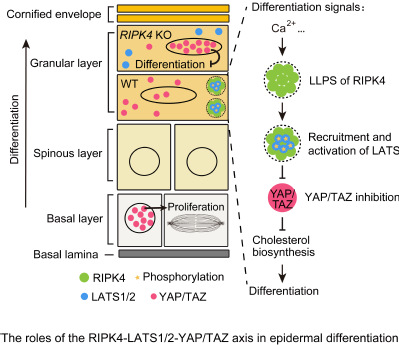On June 25, 2025, the laboratory of Professor Bin Zhao at our institute published a research article titled RIPK4 promotes epidermal differentiation through phase separation and activation of LATS1/2 online in Developmental Cell. Using tools such as skin organoids, knockout and knockin mice, this work elucidates the regulatory mechanism of the RIPK4-initiated non-canonical Hippo pathway in epidermal differentiation and reveals the role of phase separation in cell differentiation.

The skin epidermis serves as a protective barrier for mammals against pathogens and dehydration. It originates from the ectoderm during the embryonic stage, which stratifies into a multilayered epithelium known as the interfollicular epidermis, along with associated appendages. During epidermal stratification, proliferative progenitor cells in the basal layer detach from the basal membrane, migrate upward, and differentiate into three suprabasal layers: the spinous layer, the granular layer, and the stratum corneum. This process relies on coordinated cell proliferation and differentiation, the molecular mechanisms of which remain incompletely elucidated. The Hippo pathway plays a crucial role in restricting organ size. In vitro studies have shown that it senses environmental mechanical signals and chemical signals mediated by factors like GPCRs. It regulates processes such as cell proliferation, apoptosis, stem cell self-renewal, and differentiation through the core kinase cascade MST1/2-LATS1/2, which phosphorylates and inhibits the transcriptional co-activators YAP/TAZ. However, a major unresolved question in the Hippo pathway field is: Where do the signals regulating Hippo pathway activity originate under physiological conditions, and what are the mechanisms?
In this study, RIPK4 was identified as an alternative upstream kinase of LATS1/2 through screening a kinome library. Mutations in RIPK4 are responsible for Bartsocas-Papas syndrome, an autosomal-recessive form of popliteal pterygium syndrome characterized by epithelial fusion and ectodermal dysplasia. Ripk4 knockout mice phenocopies the human disease. In this work, Ripk4 knockout was found to result in activation of Hippo pathway effectors Yap/Taz in the granular layer, which subsequently represses cholesterol biosynthesis. Furthermore, the ablation of Yap/Taz partially rescued skin barrier defects. Mechanistically, RIPK4 directly phosphorylates LATS1/2 after recruiting them into liquid condensates. Disease-derived RIPK4 mutants exhibit defects in LATS1/2 activation either due to impaired kinase activity or disrupted phase separation.
This work reveals that the RIPK4-initiated non-canonical Hippo pathway plays a specific role in epidermal differentiation and provides new insights into the mechanisms and potential treatments for genetic diseases like Bartsocas-Papas syndrome. Postdoctoral fellow Xiaolei Cao from Zhao Lab is the first author. The study was done in collaboration with groups of Drs. Li Li, Li Shen, Xin-Hua Feng, Huasong Lu, Hai Song, Cunqi Ye and Ting Chen. Funding was provided by the National Natural Science Foundation of China, and the Natural Science Foundation of Zhejiang.
Link to original article: https://www.sciencedirect.com/science/article/pii/S1534580725003284



